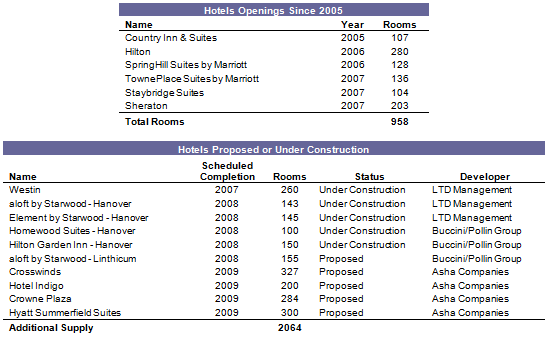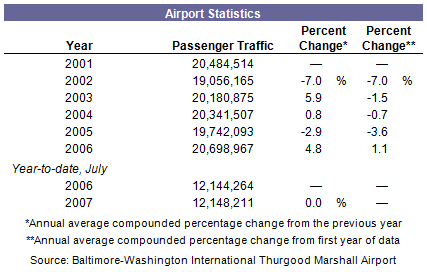
The influx of new hotels to the Baltimore-Washington International (BWI) Airport market shows no signs of slowing in the near term. Yet, while heightened airport traffic has spurred demand in recent years, the primary motive for the supply increase rests on an expected surge in job growth from major government, military, and defense-contractor sources.
The Department of Defense’s Base Realignment and Closure (BRAC) recommendation became law in 2005, consolidating thousands of defense-related jobs from around the country at the nearby Fort Meade military base. According to the BWI Business Partnership, Fort Meade serves as one of the prime “economic engines” for the area, housing more than 80 organizations representing all five branches of the military and numerous federal agencies within its compound. The BRAC process is expected to bring 5,717 new jobs to the area by 2011, most of which will belong to the Defense Information Systems Agency, which was recently reassigned to Fort Meade. Approximately 4,000 new jobs will come to the National Security Agency, Fort Meade’s largest tenant, as well as approximately 12,000 private-sector jobs over the next six years. To generate the funds needed to support such voluminous growth, the base is reportedly leasing approximately 540 acres of federal land for private development. The economic impact of the realignment is expected to contribute an additional $1 billion to the community within the next 15 years.
The BWI district’s lodging market has shown year-over-year supply increases throughout the past decade. Since 2000, 14 hotels have entered the market totaling an additional 1,976 rooms. The BRAC process has stimulated the majority of this growth since 2005, spurring nearly half of the supply increase seen since 2000. The area’s most recent larger hotel projects include the 203-room Sheraton and the 280-room Hilton hotels, which entered the market in 2006/07. Five hotels totaling 798 rooms, including the 260-room Westin and several limited- and select-service property types, are in the pipeline and expected to open by year-end 2008. Five additional hotels comprising 1,266 rooms are currently in the permitting stage; these include the Crosswinds Resort, a $375-million project targeted to open by year-end 2009, pending approval. The Resort will comprise four hotels totaling 1,111 guestrooms, a 90,000-square-foot conference center, 100,000 square feet of mixed-use space, and a 125,000-square-foot indoor aquatic center. The following tables illustrate additional supply expected in the market and the new supply that entered in 2005 following the BRAC consolidation:

As noted in the table below, the market area illustrated a decline in occupancy in 2006; this trend is attributed to new supply entering the market in the most recent years, notably the 280-room Hilton. Nonetheless, the additional supply seems justifiable given historically high occupancy levels and a suffusion of major corporate- and government-related demand generators. Occupancy is still strong within the BWI market and, despite the mounting supply scheduled to rise over the next several years, should improve going forward as the BRAC process triggers demand for potentially thousands of additional room nights.
Full-service hotels, notably the Sheraton and Hilton, have helped stimulate the market’s overall average rate growth within the last year. Although occupancy fell from 2005 to 2006, average rate levels improved in 2006, noting a 7.59% increase from the previous year. In addition, RevPAR increased from 2005 levels. In order to stay competitive with the new supply, older properties such as the Embassy Suites and Marriott have undergone extensive renovations, allowing them to command a comparatively higher room rate. The following table illustrates estimated occupancy and average rate levels for a select set of full- and select-service hotels within the BWI Airport market:

The Baltimore-Washington International Airport both services and drives regionally-based corporate and government activity. In 2006, passenger traffic increased by 4.8% from the previous year, representing an all-time record at the airport (information pertaining to airport statistics is noted in the table below). In addition to the market’s dependence on airport demand, leisure activity at places such as Arundel Mills Mall, the Harbor Place waterfront, and various downtown Baltimore attractions, as well as the popularity of sporting events, also support surrounding airport properties with sizeable compression.


0 Comments
Success
It will be displayed once approved by an administrator.
Thank you.
Error